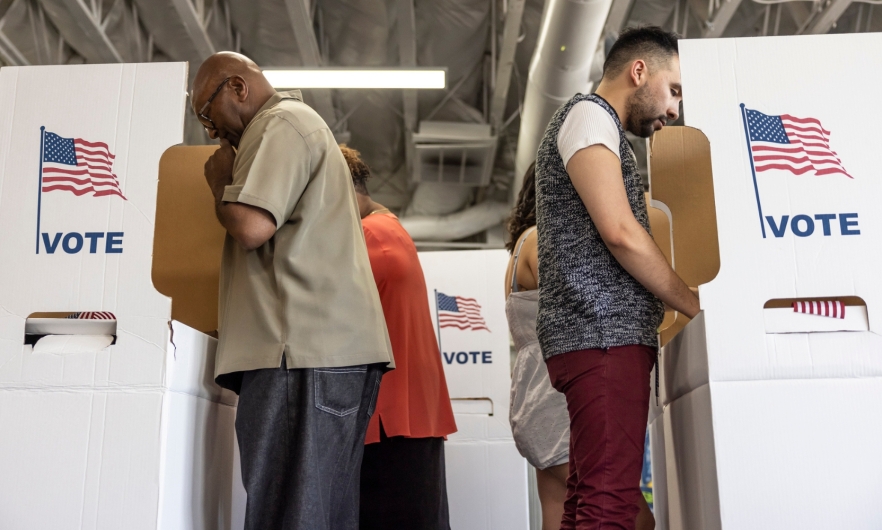What’s at Stake for Public Health in the 2024 U.S. Election?
Experts share how they expect a Harris or Trump administration would affect abortion access, health care costs, federal agencies, global health, gun violence, and immigration.

Editor’s note: The information presented in this article reflects the opinions of the experts interviewed for the Public Health On Call podcast’s special Election 2024 series. Full episodes can be accessed using the embedded players or by searching Public Health On Call wherever you listen to podcasts. As a nonprofit entity, the Johns Hopkins University cannot take a position for or against any candidate running for elected office. Information is being provided solely for academic or educational purposes and is not an endorsement of any individual candidate.
The last eight years have been uniquely challenging for public health. A global pandemic, a supercharged Supreme Court regulating reproductive and environmental health, and rising threats from infectious diseases, violence, and climate have stressed an already fractured and largely underfunded system. But there have also been incredible opportunities and wins, from COVID-19 vaccines to Medicaid/Medicare expansions and a promising new infrastructure bill.
All of this has taken place across two very different administrations. The 2024 election finds public health at a moment with unique opportunities and threats.
The Election 2024 series from the Public Health On Call podcast looks at what’s top of mind for public health experts for this election across topics such as health policy, preventing gun violence, legislating reproductive health, and immigration.
Jump to section:
What’s at Stake for Abortion Access?
It’s the first presidential general election since the 2022 Dobbs decision ended the federal right to abortion. Joanne Rosen, JD, MA, a practice professor in Health Policy and Management and an expert in reproductive law, explains that from state legislatures and ballot initiatives to Congress and the presidential election, “abortion is very much on the ballot.”
Abortion Access at the State Level
“The overwhelming majority of abortion regulations are enacted at the state level, not at Congress,” says Rosen. Since Dobbs, many states have passed abortion-related legislation from enacting full bans to protecting full access.
This November, ten states—Arizona, Colorado, Florida, Maryland, Missouri, Montana, Nebraska, Nevada, New York, and South Dakota—have abortion-related initiatives on their ballots. Many of these states currently restrict abortion, “and these initiatives would expand abortion access in those states,” says Rosen. In addition to ballot initiatives, voters in almost every state will elect positions that determine state abortion laws: 11 states will vote for their governors, and 44 states will choose state legislators.
Abortion Access at the Federal Level
At the federal level, a nationwide ban on—or full protection of—abortion is possible, Rosen says, but complicated to achieve. She points to the failure of the Women’s Health Protection Act, which has been introduced numerous times since 2013 but has always died in committee.
"One of the most potent powers that a president has is the power to nominate judges at all levels."
But there are still direct and indirect ways that the president and the makeup of Congress can dramatically influence abortion access nationally. “One of the most potent powers that a president has is the power to nominate judges at all levels,” Rosen says. This includes appointing Supreme Court justices; Trump’s first term appointments showed just how impactful those decisions can be. The president can also nominate judges at lower courts, where abortion legislation is highly likely to play out.
Access to Medication Abortion
Medication abortion is the most common type of abortion procedure—in 2023, 63% of all abortions were medication abortions. According to Rosen, there has been a lot of discussion and even attempts in recent years to use the 1873 Comstock Act to effectively ban abortion nationwide by restricting distribution of mifepristone. A president could call for aggressive enforcement of the Comstock Act or Congress could vote to amend or repeal the Act, preventing it from being used in this way.
Separately, Project 2025 proposes revoking the FDA’s approval of mifepristone. Doing so would take mifepristone off the market nationwide. That could be challenged in court, whose decision could be impacted by the judges a president has appointed.
What's at Stake for Global Health?
Foreign health policy hasn’t historically played a major role in U.S. presidential elections, but 2024 is an outlier. That’s because typically, there’s been bipartisan alignment on global health policies like efforts to eradicate HIV, malaria, and TB, says Thomas Bollyky, JD, inaugural Bloomberg Chair in Global Health at the Council on Foreign Relations. But, he says, the “America first” mindset of both the Trump and Biden administrations has changed things significantly.
Regardless of the election’s outcome, “we are at an inflection moment,” Bollyky says. “The bipartisan consensus that existed around global public health for two decades is gone.” He explains the potential direct and indirect implications of a Trump or Harris administration on global health.
U.S. Alignment with the WHO
If elected to a second term as president, Trump “has been clear that he does intend to withdraw from the World Health Organization,” says Bollyky, an action that would likely take place in the first 60 days of a new administration. Trump began this process in 2020, placing a notice of withdrawal from the WHO; Biden rejoined on Day 1 of his presidency, before the one-year waiting period of withdrawal had completed.
Implications for Pandemic Preparedness
Trump and Harris would have very different approaches to pandemic preparedness moving forward.
When COVID hit the U.S. in 2020, “pandemic preparedness and response—and public health in general—was politicized as a threat to [the] American way of life, liberty and the pursuit of happiness rather than just the way that we protect our national security, our economy, and individuals and communities,” Bollyky says.
“We are at an inflection moment ... The bipartisan consensus that existed around global public health for two decades is gone.”
The Biden-Harris administration has overseen concerted efforts and investments to coordinate the U.S.’s activities internationally and domestically around responding to global public health emergencies. This includes the new Office of Pandemic Preparedness and Response Policy, established by Congress in 2023. Trump would likely disband that office, Bollyky says, focusing instead on response once a pandemic occurs.
How U.S. Domestic Policy Impacts International Policy
Indirectly, Bollyky says, the U.S.’s general views on health at home impact policies worldwide. An administration that supports abortion access, for example, might provide more assistance for women’s reproductive health globally—global development assistance for reproductive health increased 47% under Biden while declining 42% under Trump.
Historically, this dynamic also played out in the response to the HIV/AIDS crisis. The combined efforts of activists, policymakers, and international partners, helped “extend the same hard-won antiretroviral therapies to Sub-Saharan Africa and other nations as we had domestically,” Bollyky explains.
What’s at Stake for Health Insurance, Medicare/Medicaid, and Drug Pricing?
Unlike in previous elections, this year there isn’t one overarching health insurance issue each candidate is focused on, says Gerard Anderson, PhD, professor in Health Policy and Management and International Health. But there are still plenty of impacts a future Trump or Harris administration could have on how Americans access essential health care, he explains.
Impacts to Health Insurance Access
Health insurance in the U.S. is complicated, but the underlying concept, says Anderson, is that “we're all in it together and we all take care of each other.” That is what the Affordable Care Act has aimed to achieve, particularly through its inclusion of people with pre-existing conditions.
“Harris is very supportive of all of the help that the ACA has done,” says Anderson, who expects she would maintain and build on its success. “If you have chronic conditions and you are sick, the options that the Harris administration effectively gives you will protect you from high costs [and] protect you from losing your coverage,” he says.
Trump has not yet articulated a plan for replacing the ACA, Anderson says, “but he seems to be saying he wants the healthy people to have another option, which is a lower cost option that they can benefit from, that the people with chronic conditions and severe illnesses will have trouble accessing.”
Potential Impacts to Drug Pricing
The Biden-Harris administration made some major changes to drug costs through the 2022 Inflation Reduction Act. They have negotiated lower prices on ten drugs that make up nearly 20% of Medicare Part D spending, with plans to add more drugs to that list in the years ahead.
During his first term, Trump proposed a similar plan that never got enacted: A negotiation of prices of physician-administered drugs through Medicare Part B "that would reduce the prices for most of these Part B drugs by 50%, 100%, even 200%, depending on the drug," Anderson says, noting that it’s unclear whether Trump would try this tactic again. “It would reduce prices to international standards, but it's vehemently opposed by the pharmaceutical industry, which is a major supporter of former President Trump.”
"The whole concept of health insurance ... is we're all in it together and we all take care of each other."
The Future of Medicaid Expansion and Medicare Plans
The ACA included expanding Medicaid to cover people with household incomes under a certain level. Using federal incentives that covered 90% of the cost, 40 states and Washington D.C. have expanded access so far. Harris is in favor of retaining Medicaid expansion and Anderson expects that she’ll provide additional financial incentives for the 10 states that have not yet adopted the expansion.
A Trump administration could undo the Medicaid expansion or reduce participation in it. If the federal government under Trump reduced how much of the costs they cover, some states could decide to drop out of the expansion causing people to lose their coverage. There’s also been discussion for a second Trump term of states imposing work requirements for people to receive Medicaid benefits, making it harder for people to get coverage.
As for Medicare, both Trump and Harris have said they want to maintain eligibility and coverage, according to Anderson. “The big debate will be on Medicare Advantage,” he says, referencing the Medicare health plans offered by private companies that are used by more than half of Medicare beneficiaries.
“[The] Trump administration wants to make everybody [move to]private sector plans and take away what's called ‘traditional Medicare,’ or to reduce the number of people [using] that option,” Anderson says. He expects a Trump administration would try to make it easier and more appealing to use Medicare Advantage, while making it more difficult to access traditional Medicare.
What at Stake for Public Health and Federal Agencies?
Public health is often invisible: “When our best work is done, nothing happens,” explains Georges Benjamin, executive director of the American Public Health Administration. But the lifesaving work of public health in the U.S. relies on a powerful infrastructure that includes the FDA, the CDC, the EPA, and other federal agencies.
To consider an election’s impact on these core agencies, Benjamin looks at a few aspects of each candidate: the leadership they appoint, the funding they allocate, and their approaches to problem solving. “When you think about those three core areas, I think we have stark differences in the candidates that we have to vote for this year,” he says.
Leadership in Federal Agencies
“Personnel is policy,” explains Benjamin, pointing to how Harris and Trump have appointed—or might appoint—individuals to critical roles. For example, both the Biden/Harris and Trump administrations had very qualified FDA commissioners, according to Benjamin but there were differences in how those appointees were empowered to implement sound policies.
The current Biden-Harris administration has appointed people who are “highly competent [and] qualified,” Benjamin says, and whose policies “have been proactive in terms of promoting health, and clearly using science and evidence” to make decisions. On the other hand, while Trump appointed competent people to similar key roles, “he often didn’t let them do their thing,” Benjamin says.
Funding for Federal Agencies
The strength of agencies like the CDC and the FDA are determined in large part by how well they are funded. A Trump administration would likely result in significantly decreased funding, Benjamin says, noting that Project 2025 recommends dramatic cuts to CDC funding. “Under a weak CDC, we won't have anyone really doing prevention,” he says. This would mean underinvestment in essential efforts to prevent and reduce the burden of leading causes of death like heart disease, accidents, cancer, and strokes, as well as pandemics and seasonal viruses like influenza, COVID, and RSV.
There are also efforts within the budget proposals put forth by the Republican-led House of Representatives that, according to Benjamin, would dramatically reduce funding for almost all science-related public agencies and their front-leaning programs. “And not just simply capping them at some low growth level, but really dramatic reductions in their funding,” he says.
“When you think about those three core areas, I think we have stark differences in the candidates that we have to vote for this year.”
The Authority Agencies Have To Do Their Work
Further complicating things: the Supreme Court’s decision to throw out the Chevron doctrine undermines federal authority and makes its regulations vulnerable to the decisions of judges, rather than subject matter experts. “I would be very concerned about an administrative agency like the FDA … having its decision second-guessed by the courts,” says Benjamin, who believes a Trump administration would be more likely to defer to the courts, roll back regulations, and rely on the private sector to do the right thing.
Without the regulations we have today from agencies like the FDA and the EPA, “the food would not be safe to eat, the water would not be safe to drink, and the air wouldn't be safe to breathe,” Benjamin says. Further, underserved and low-income communities would bear the brunt of these decisions. These communities that are already disproportionately impacted by environmental and health threats, “would disproportionately be injured by not being more thoughtful about our regulatory apparatus and who we put in those jobs.”
What’s at Stake for Gun Violence Prevention?
For many Americans, gun violence is a key issue. According to an analysis of CDC mortality data by the Johns Hopkins Center for Gun Violence Solutions, guns have been the leading cause of death among children and teens ages 1-17 every year since 2020. In 2023 alone, 27,300 people died by gun suicide, the highest annual total ever recorded.
It’s also a largely bipartisan one for voters: Every two years since 2013, the Center for Gun Violence Solutions has polled Americans about their opinions on several gun violence policies. Their surveys show that a majority of Americans support policies that have proven effective at or show promise for reducing gun violence. “We have much more common ground on these than people think,” says Center co-director Cass Crifasi, PhD, MPH.
Presidential and vice presidential candidates from both campaigns have addressed the topic in speeches and debates, and there are stark differences in how Harris and Trump presidencies would impact gun violence and policies to prevent it. Crifasi and Center co-director Josh Horwitz, JD, explain what a Harris or Trump administration would mean for implementing evidence-based policies to prevent gun violence.
Resource Allocation for Gun Violence Prevention
According to Crifasi and Horwitz, the biggest impact of a Trump administration would be in funding and resource allocation—for everything from state and federal gun policy enforcement, to continued implementation of the Bipartisan Safer Communities Act. For example, it would likely result in cutting back or eliminating resources for the Department of Justice to continue its efforts in gun violence reduction and crisis intervention.
A Trump administration would also impact gun violence research. The Biden-Harris administration “made money available through the CDC and the NIH for researchers like Professor Crifasi to be able to study some of the most important issues that we have today in gun violence,” Horwitz says. This is funding, he says, that has made a big difference already, but that the current Republican-controlled House of Representatives has already attempted to roll back that funding.
"It's important that we have an administration that is going to focus on balancing rights and responsibilities of gun ownership.”
Funding is also needed to carry out the gun policies that are already on the books. According to Crifasi and Horwitz, a Trump administration would also make enforcing gun laws harder at both the state and federal levels—not only due to lack of resources, but also due to a shift in tone around enforcement. For example, investment in the Bureau of Alcohol, Tobacco, Firearms and Explosives determines how frequently and thoroughly licensed gun dealers can be inspected and whether people are held accountable for carrying guns across state lines. “We can have laws on the books,” Crifasi says. “But if we don't enforce them … they’re just words on a page.”
Evidence-Based Solutions To Prevent Gun Violence
The Biden-Harris administration set up the first Office of Gun Violence Prevention in 2023, marking a critical milestone in federal efforts to curb gun violence. “Staffed by very seasoned professionals and headed by Vice President Harris, … [the office] helped create a number of different executive orders and also worked on the implementation of the [Bipartisan] Safer Communities Act,” explains Horwitz.
During her time as vice president and on the campaign trail, Harris discusses gun violence openly, clearly, and with a focus on solutions, says Crifasi. She and Horwitz believe this would be reflected in Harris’s priorities as president: effectively funding research, and implementing and evaluating policies—things like ERPOs and community mental health clinics—based on that research.
“As a public health researcher who has spent more than a decade very specifically evaluating the effects of policies and programs to reduce gun violence—and as a proud gun owner—it's very clear to me that … a future potential Harris administration would really be applying a public health approach to this problem,” Crifasi says. “As we approach 2025 and what we need to be doing for the safety and security of our children, it's important that we have an administration that is going to focus on balancing rights and responsibilities of gun ownership.”
What’s at Stake for Immigrants and Immigration?
The U.S. is often referred to as “a nation of immigrants,” a multicultural society that welcomes people of all backgrounds. Heading into the 2024 election, immigration is not only a top issue for voters—it’s also a highly polarizing one.
Extreme rhetoric on the campaign trail—as well as residual effects of policies enacted during the Trump administration—are already impacting the lives of immigrants in the U.S., explains Kiara Álvarez, PhD, an assistant professor in Health, Behavior and Society, and Sarah Polk, MD, an assistant professor of pediatrics at the Johns Hopkins School of Medicine and co-director of pediatrics at Centro SOL.
Ripple Effects of Polarizing Rhetoric
When Álvarez thinks about this year’s election as relates to immigration, what’s most prominent in her mind is the “extreme rhetoric from the Trump campaign regarding immigrants and immigration.” Trump has repeatedly touted the Republican Party’s plan for mass deportation of the approximately 11 million undocumented immigrants living in the U.S. Álvarez says that while such action may be logistically impossible, the threat itself sows fear in immigrants and people of color.
She points to the recent false accusations of Haitian immigrants in Springfield, Ohio, and how the narrative—despite being proven untrue—was weaponized to cause real consequences and threats of violence. “We see the way that that tears at the social fabric of a community where immigrants had been welcomed and … continue to make really important contributions to the community,” Álvarez says.
"We see the way that that tears at the social fabric of a community where immigrants had been welcomed and … continue to make really important contributions to the community."
In her work as a mental health clinician, Álvarez sees this emphasis on division and violence causing fear and anxiety in immigrant families: worries about their safety and well-being, the potential for parents and children to be separated, and their sense of belonging—in the U.S. or even to their own culture. “We know from research that feeling a sense of pride in your history and your culture is very protective for youth of all backgrounds,” she says, noting that immigrant families are hesitant to even speak their native language in public out of fear of being targeted or harmed for it.
Congressional Action on Immigration Reform
Congress has fallen short in passing comprehensive immigration reform for decades, says Álvarez. She points to the recent border bill that came very close to passing earlier this year. “A bipartisan solution is very important, but we have seen that fail over and over again,” says Álvarez. Instead, temporary solutions leave people in limbo, like the hundreds of thousands granted temporary protected status in 2012 through Deferred Action for Childhood Arrivals. “Youth who are now adults—who have been in the country most of their lives and are contributing in terms of education, in terms of the economy, in terms of their work—still have no certainty about their outcomes,” she says.
Access to Public Benefits
Most immigration discussions focus on border security, says Álvarez, rather than on the rights and roles of immigrants living here. Under the 14th amendment, children born to undocumented immigrants in the U.S. are U.S. citizens. As such, they are eligible for public benefits like health insurance and food assistance, but many immigrant families who need these benefits have been afraid to use them, says Polk.
This fear stems, she says, from a “public charge” rule that was proposed by the Trump administration—but never fully enacted—stating that if children of immigrants used public health insurance or the Supplemental Nutrition Assistance Program that they were eligible for as citizens, it could be held against their parents’ application for citizenship. According to Polk, the Biden-Harris administration and the Harris-Walz campaign have not threatened to act on the public charge or limit public benefits for these eligible citizens.
Aliza Rosen is a digital content strategist in the Office of External Affairs at the Johns Hopkins Bloomberg School of Public Health.
Related:
More from the Bloomberg School
- See latest headlines
- Learn more about our departments:





